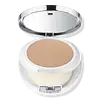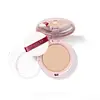Clinique Beyond Perfecting Powder Foundation + Concealer Versus Wander Beauty Wanderlust Powder Foundation
What's inside
What's inside
 Key Ingredients
Key Ingredients

 Benefits
Benefits

 Concerns
Concerns

 Ingredients Side-by-side
Ingredients Side-by-side

Talc
AbrasiveOctyldodecyl Stearoyl Stearate
EmollientZinc Stearate
Cosmetic ColorantZinc Laurate
Dimethicone
EmollientBentonite
AbsorbentHdi/Trimethylol Hexyllactone Crosspolymer
Silica
AbrasiveAstrocaryum Murumuru Seed Butter
EmollientGlycerin
HumectantSqualane
EmollientLauroyl Lysine
Skin ConditioningHydrolyzed Soy Protein
HumectantCetearyl Dimethicone Crosspolymer
Lecithin
EmollientTocopheryl Acetate
AntioxidantTetrahexyldecyl Ascorbate
AntioxidantWater
Skin ConditioningMagnesium Myristate
Potassium Sorbate
PreservativeCoconut Acid
CleansingTetrasodium EDTA
Chlorphenesin
AntimicrobialMica
Cosmetic ColorantCI 77891
Cosmetic ColorantCI 77491
Cosmetic ColorantCI 77492
Cosmetic ColorantCI 77499
Cosmetic ColorantCI 77007
Cosmetic ColorantCI 77163
Cosmetic ColorantCI 15850
Cosmetic ColorantCI 42090
Cosmetic ColorantCI 75470
Cosmetic ColorantTalc, Octyldodecyl Stearoyl Stearate, Zinc Stearate, Zinc Laurate, Dimethicone, Bentonite, Hdi/Trimethylol Hexyllactone Crosspolymer, Silica, Astrocaryum Murumuru Seed Butter, Glycerin, Squalane, Lauroyl Lysine, Hydrolyzed Soy Protein, Cetearyl Dimethicone Crosspolymer, Lecithin, Tocopheryl Acetate, Tetrahexyldecyl Ascorbate, Water, Magnesium Myristate, Potassium Sorbate, Coconut Acid, Tetrasodium EDTA, Chlorphenesin, Mica, CI 77891, CI 77491, CI 77492, CI 77499, CI 77007, CI 77163, CI 15850, CI 42090, CI 75470
Mica
Cosmetic ColorantSilica
AbrasiveDimethicone
EmollientBoron Nitride
AbsorbentVinyl Dimethicone/Methicone Silsesquioxane Crosspolymer
Nylon-12
Phenyl Trimethicone
Skin ConditioningCaprylyl Glycol
EmollientTriethoxycaprylylsilane
Dimethicone/Vinyl Dimethicone Crosspolymer
Skin Conditioning1,2-Hexanediol
Skin ConditioningEthylhexylglycerin
Skin ConditioningAllantoin
Skin ConditioningWater
Skin ConditioningJojoba Esters
EmollientTocopheryl Acetate
AntioxidantButylene Glycol
HumectantHibiscus Sabdariffa Flower Extract
Skin ConditioningAloe Barbadensis Leaf Extract
EmollientCarthamus Tinctorius Flower Extract
Skin ConditioningChrysanthellum Indicum Extract
Skin ConditioningLonicera Japonica Flower Extract
Skin ConditioningNelumbo Nucifera Flower Extract
Skin ConditioningPhenoxyethanol
PreservativeSodium Hyaluronate
HumectantTitanium Dioxide
Cosmetic ColorantCI 77492
Cosmetic ColorantCI 77491
Cosmetic ColorantCI 77499
Cosmetic ColorantMica, Silica, Dimethicone, Boron Nitride, Vinyl Dimethicone/Methicone Silsesquioxane Crosspolymer, Nylon-12, Phenyl Trimethicone, Caprylyl Glycol, Triethoxycaprylylsilane, Dimethicone/Vinyl Dimethicone Crosspolymer, 1,2-Hexanediol, Ethylhexylglycerin, Allantoin, Water, Jojoba Esters, Tocopheryl Acetate, Butylene Glycol, Hibiscus Sabdariffa Flower Extract, Aloe Barbadensis Leaf Extract, Carthamus Tinctorius Flower Extract, Chrysanthellum Indicum Extract, Lonicera Japonica Flower Extract, Nelumbo Nucifera Flower Extract, Phenoxyethanol, Sodium Hyaluronate, Titanium Dioxide, CI 77492, CI 77491, CI 77499
Ingredients Explained
These ingredients are found in both products.
Ingredients higher up in an ingredient list are typically present in a larger amount.
Ci 77491 is also hydrated iron III oxide. It's sole purpose is to give a red/pink hue to products.
Iron III oxides are classified as inorganic chemicals for coloring.
Synthetically created Ci 77491 is considered safer than those naturally found. This is because the synthetically created version may contain less impurities. Iron oxides are generally non-toxic and non-allergenic.
Learn more about CI 77491Ci 77492 is also hydrated iron III oxide. It's sole purpose is to give a yellow hue to products.
Iron III oxides are classified as inorganic chemicals for coloring.
Synthetically created Ci 77492 is considered safer than those naturally found. This is because the synthetically created version may contain less impurities. Iron oxides are generally non-toxic and non-allergenic.
Learn more about CI 77492Ci 77499 is also hydrated iron III oxide. It is created from mixing red and black iron oxides. This helps give shades of darkness to a product.
Iron III oxides are classified as inorganic chemicals for coloring.
Dimethicone is a type of synthetic silicone created from natural materials such as quartz.
What it does:
Dimethicone comes in different viscosities:
Depending on the viscosity, dimethicone has different properties.
Ingredients lists don't always show which type is used, so we recommend reaching out to the brand if you have questions about the viscosity.
This ingredient is unlikely to cause irritation because it does not get absorbed into skin. However, people with silicone allergies should be careful about using this ingredient.
Note: Dimethicone may contribute to pilling. This is because it is not oil or water soluble, so pilling may occur when layered with products. When mixed with heavy oils in a formula, the outcome is also quite greasy.
Learn more about DimethiconeMica is a naturally occurring mineral used to add shimmer and color in cosmetics. It can also help improve the texture of a product or give it an opaque, white/silver color.
Serecite is the name for very fine but ragged grains of mica.
This ingredient is often coated with metal oxides like titanium dioxide. Trace amounts of heavy metals may be found in mica, but these metals are not harmful in our personal products.
Mica has been used since prehistoric times throughout the world. Ancient Egyptian, Indian, Greek, Roman, Aztec, and Chinese civilizations have used mica.
Learn more about MicaSilica, also known as silicon dioxide, is a naturally occurring mineral. It is used as a fine, spherical, and porous powder in cosmetics.
Though it has exfoliant properties, the function of silica varies depending on the product.
The unique structure of silica enhances the spreadability and adds smoothness, making it a great texture enhancer.
It is also used as an active carrier, emulsifier, and mattifier due to its ability to absorb excess oil.
In some products, tiny microneedles called spicules are made from silica or hydrolyzed sponge. When you rub them in, they lightly polish away dead skin layers and enhance the penetration of active ingredients.
Learn more about SilicaTocopheryl Acetate is AKA Vitamin E. It is an antioxidant and protects your skin from free radicals. Free radicals damage the skin by breaking down collagen.
One study found using Tocopheryl Acetate with Vitamin C decreased the number of sunburned cells.
Tocopheryl Acetate is commonly found in both skincare and dietary supplements.
Learn more about Tocopheryl AcetateWater. It's the most common cosmetic ingredient of all. You'll usually see it at the top of ingredient lists, meaning that it makes up the largest part of the product.
So why is it so popular? Water most often acts as a solvent - this means that it helps dissolve other ingredients into the formulation.
You'll also recognize water as that liquid we all need to stay alive. If you see this, drink a glass of water. Stay hydrated!
Learn more about Water